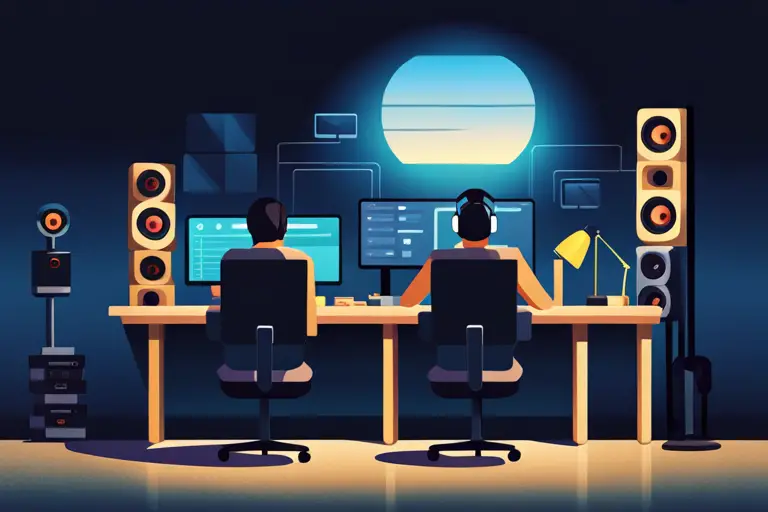Are you looking to take your podcast to the next level? One of the most important factors in creating a successful podcast is having high-quality audio production. But if you’re new to audio editing and mixing, it can be overwhelming to know where to start. Fear not, because in this article, you will learn the basics of mastering audio production for podcasts.
First and foremost, it’s important to understand the basics of audio production. This includes knowing the different types of microphones, recording techniques, and editing software. You’ll also want to consider the equipment you’ll need for your podcast, from microphones to headphones to audio interfaces.
Once you have the right tools, you can begin recording and editing your podcast to create a professional sound that will engage and entertain your listeners. So let’s dive in and master the art of audio production for podcasts!
Understanding the Basics of Audio Production
Let’s start by getting cozy in our soundproofed studio and diving into the basics of audio production. To begin with, audio production is the process of recording, editing, and mastering sound to create a final product that’s ready for distribution.
This process involves several steps, including setting up the recording equipment, recording the audio, editing and enhancing the sound, and finally mixing and mastering the audio to achieve the desired sound quality.
When it comes to audio production for podcasts, understanding the basics is crucial. This means having a good understanding of the equipment you’ll be using, such as microphones, mixing boards, and audio editing software.
You’ll also need to have a good ear for sound and be able to identify and correct any issues that may arise during the recording and editing process.
With a solid foundation in the basics of audio production, you can create high-quality podcasts that’ll engage and entertain your audience.
Choosing the Right Equipment for Your Podcast
You’ll need to carefully consider which equipment is best suited for your podcast in order to make it sound professional and engaging.
Firstly, you’ll need a microphone that can capture high-quality audio. There are a variety of options available, ranging from USB microphones to XLR microphones that require an audio interface.
USB microphones are a great option if you’re just starting out, as they’re easy to use and don’t require any additional equipment. However, if you’re looking for the best possible sound quality, an XLR microphone and audio interface will provide you with more control over your audio levels and allow you to adjust your sound to your specific needs.
In addition to a microphone, you’ll need headphones to monitor your audio. This will allow you to hear any background noise or other issues that may affect the quality of your recording.
When choosing headphones, it’s important to look for a pair that are comfortable to wear for long periods of time and provide accurate sound reproduction. You’ll also need to consider whether you want open or closed-back headphones.
Closed-back headphones are more isolating and will block out more external noise, whereas open-back headphones allow for a more natural sound and are often preferred by podcasters who want to be able to hear themselves and their guests more clearly.
By choosing the right equipment for your podcast, you’ll be well on your way to producing professional-quality audio that will engage your listeners and keep them coming back for more.
Recording Techniques for High-Quality Audio
To capture clear and crisp audio for your podcast, imagine you’re in a soundproof booth. Position your microphone close to your mouth, while avoiding any unnecessary movements or background noise. This will help you capture your voice clearly without any distortion. It’s also important to speak at a consistent volume and pace so your listeners can follow along easily.
Another important technique is to use a pop filter or windscreen to reduce plosives and other unwanted sounds. These tools help prevent harsh breathing sounds, popping ‘P’sounds, and other distracting noises that can ruin the quality of your recording. Additionally, experiment with microphone placement and distance to find the optimal settings that work best for your voice and recording environment.
By mastering these recording techniques, you’ll be able to create high-quality audio that engages your audience and enhances your podcast content.
Editing and Mixing Your Audio Files
Editing and mixing audio files can take your podcast from good to great, allowing you to fine-tune your recordings and create a polished final product. When it comes to editing, it’s important to listen to your audio carefully and remove any unwanted noise or mistakes. This includes cutting out long pauses, vocal tics, and background noise. You can also use editing software to adjust the volume levels of different tracks and add effects like EQ and compression to enhance the sound quality.
Mixing is the process of blending all the different audio tracks together so that they sound balanced and cohesive. This involves adjusting the levels of each track and panning them to create a sense of space and depth. You can also add additional effects like reverb or delay to create a more dynamic and interesting sound.
Remember to always listen to your mixes on different devices and in different environments to ensure that they sound great on all platforms. With a little practice and attention to detail, you can edit and mix your audio files like a pro and create a podcast that sounds polished and professional.
Applying Effects for Improved Sound Quality
By adding effects like reverb or delay, your podcast can take on a more dynamic and immersive quality, as if the listener’s transported to the very scene you’re describing.
Reverb, for example, can add a sense of spaciousness and depth to your audio, making it sound like it was recorded in a larger room or even outdoors. This can be especially effective when you’re trying to create a specific mood or atmosphere, such as a sense of intimacy or grandeur.
Delay, on the other hand, can create a sense of anticipation or excitement by repeating a sound or voice in a rhythmic pattern. This can be useful for emphasizing a certain point or for building tension before a dramatic reveal.
However, it’s important not to overuse effects like reverb or delay, as they can quickly become distracting and take away from the overall quality of your podcast. By finding the right balance and using effects sparingly and purposefully, you can enhance the listening experience for your audience.
Perfecting Your Podcast’s Sound Design
Achieving a professional and engaging sound design for your podcast can make all the difference in captivating your audience and keeping them coming back for more. One way to perfect your sound design is to create a consistent sonic identity. This means using similar sound effects, transitions, and music throughout your episodes to create a cohesive listening experience.
Another key element to consider is the balance between your podcast’s narration, music, and sound effects. Make sure your narration is clear and easily heard over background music and sound effects. Use music and sound effects to enhance the mood and tone of your podcast, but be careful not to overpower your narration.
Remember, the goal is to create a balanced and enjoyable listening experience for your audience. By focusing on these aspects of sound design, you can bring your podcast to the next level and create a professional and engaging experience for your listeners.
Tips for Engaging and Entertaining Your Listeners
To keep your listeners engaged and entertained, you’ll want to focus on incorporating humor, storytelling, and personal anecdotes into your podcast.
Humor can help break up the monotony of a topic and keep your audience interested. It can also make your podcast more relatable and enjoyable.
Storytelling is another effective way to keep your listeners engaged. Sharing personal stories or anecdotes can help your audience connect with you on a more personal level and make your podcast more memorable.
Another way to engage your listeners is to involve them in your podcast. You can ask for feedback or questions from your audience and incorporate them into future episodes. This not only creates a sense of community but also shows your listeners that you value their opinions and input.
Additionally, consider having guests on your podcast to provide different perspectives and add variety. By incorporating these tips, you can keep your listeners engaged and entertained throughout your podcast.
Frequently Asked Questions
How do I promote my podcast and reach a wider audience?
To reach a wider audience, promote your podcast on social media platforms, collaborate with other podcasters, and ask listeners to leave reviews and share with their friends. Engage with your audience and create compelling content that keeps them coming back for more.
What legal considerations should I keep in mind when producing a podcast?
When producing a podcast, you need to be aware of copyright laws and obtain permission for any copyrighted material used. Additionally, consider potential defamation or privacy issues and seek legal advice if necessary.
How can I monetize my podcast and make money from it?
To monetize your podcast, focus on building an engaged audience. Then seek sponsorships or sell merchandise related to your show. Consider crowdfunding or charging for premium content like bonus episodes. Don’t forget to comply with advertising regulations.
What are some common mistakes to avoid when editing and mixing audio files?
When editing and mixing audio files, avoid common mistakes such as over-compressing, not using EQ properly, and neglecting to check for consistent volume levels. These errors can result in poor sound quality and listener disengagement.
How do I deal with difficult guests or co-hosts during recording sessions?
When dealing with difficult guests or co-hosts during recording sessions, it’s important to remain calm and professional. Address any issues respectfully and communicate clearly to ensure everyone’s needs are met.
Conclusion
Congratulations, you’ve now mastered audio production for podcasts! By understanding the basics of audio production and choosing the right equipment, you can ensure that your podcast sounds professional and engaging for your listeners.
Remember to use recording techniques that capture high-quality audio, and to take the time to edit and mix your audio files. Applying effects such as EQ and compression can greatly improve the sound quality of your podcast, and perfecting your sound design can add an extra layer of immersion for your listeners.
Finally, don’t forget to keep your listeners engaged and entertained by using storytelling techniques, incorporating music and sound effects, and varying your tone and pacing. With these tips and techniques, you’re well on your way to creating a successful and impactful podcast.

Hey there, tech enthusiasts! I’m your go-to content writer, delving into the fascinating world of technology hacks. Get ready to unlock mind-blowing secrets and discover innovative solutions through my engaging and insightful blogs.


